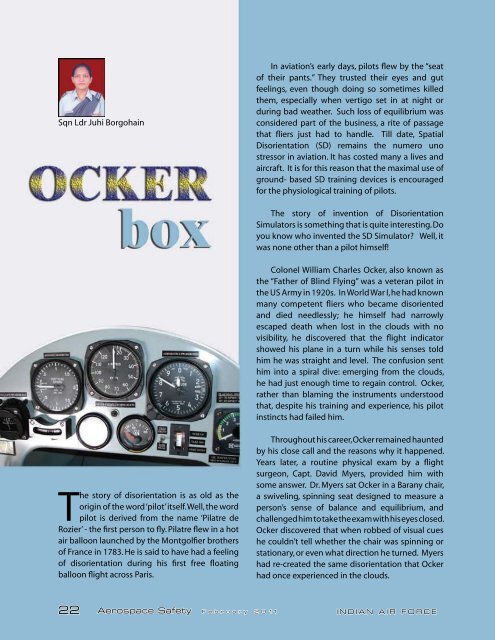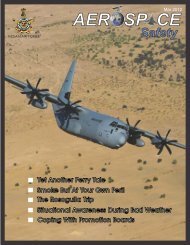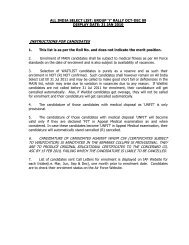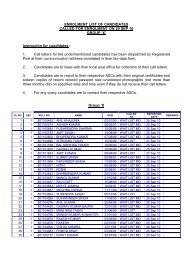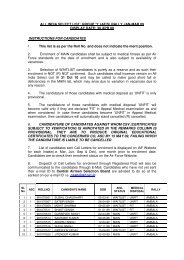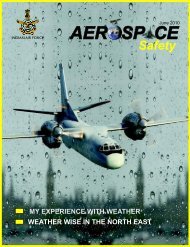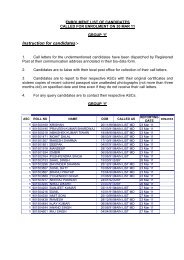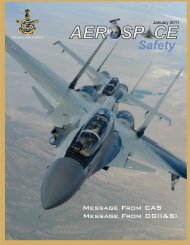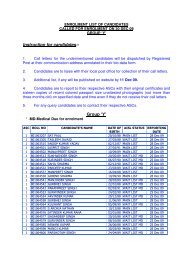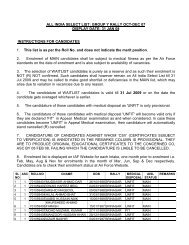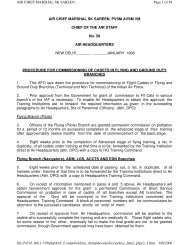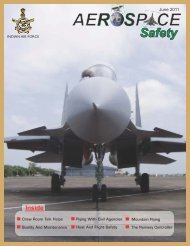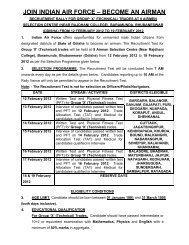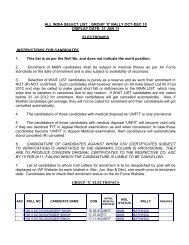Sqn Ldr Juhi BorgohainIn aviation’s early days, pilots flew by the “seatof their pants.” They trusted their eyes and gutfeelings, even though doing so sometimes killedthem, especially when vertigo set in at night orduring bad weather. Such loss of equilibrium wasconsidered part of the business, a rite of passagethat fliers just had to handle. Till date, SpatialDisorientation (SD) remains the numero unostressor in aviation. It has costed many a lives andaircraft. It is for this reason that the maximal use ofground- based SD training devices is encouragedfor the physiological training of pilots.The story of invention of DisorientationSimulators is something that is quite interesting. Doyou know who invented the SD Simulator? Well, itwas none other than a pilot himself!Colonel William Charles Ocker, also known asthe “Father of Blind Flying” was a veteran pilot inthe US Army in 1920s. In World War I, he had knownmany competent fliers who became disorientedand died needlessly; he himself had narrowlyescaped death when lost in the clouds with novisibility, he discovered that the flight indicatorshowed his plane in a turn while his senses toldhim he was straight and level. The confusion senthim into a spiral dive: emerging from the clouds,he had just enough time to regain control. Ocker,rather than blaming the instruments understoodthat, despite his training and experience, his pilotinstincts had failed him.The story of disorientation is as old as theorigin of the word ‘pilot’ itself. Well, the wordpilot is derived from the name ‘Pilatre deRozier’ - the first person to fly. Pilatre flew in a hotair balloon launched by the Montgolfier brothersof France in 1783. He is said to have had a feelingof disorientation during his first free floatingballoon flight across Paris.Throughout his career, Ocker remained hauntedby his close call and the reasons why it happened.Years later, a routine physical exam by a flightsurgeon, Capt. David Myers, provided him withsome answer. Dr. Myers sat Ocker in a Barany chair,a swiveling, spinning seat designed to measure aperson’s sense of balance and equilibrium, andchallenged him to take the exam with his eyes closed.Ocker discovered that when robbed of visual cueshe couldn’t tell whether the chair was spinning orstationary, or even what direction he turned. Myershad re-created the same disorientation that Ockerhad once experienced in the clouds.22 Aerospace Safety F e b r u a r y 2 0 11INDIAN AIR FORCE
Ocker devised a way to beat Myers’s test byrigging a turn indicator and penlight inside acovered shoe box with a viewing hole cut in oneend. Seated in the chair, he held the box up tohis face and watched only the instrument. Eventhough he was “flying blind,” he could now tellMyers precisely which way he moved and how fast.Ocker had proved that conflict can exist betweena pilot’s subjective perceptions and the readingsof his instruments—and that he should trust theinstruments, not his instincts, when that occurred.Ocker perfected his “Ocker box,” addingstandard aircraft instrumentation such as acompass and artificial horizon, so that pilots coulduse the box in conjunction with the Barany chairas a training device. Even the most experiencedaviators could not help but be convinced after aspin in Ocker’s rudimentary flight simulator.Ocker contributed tremendously to improveflight safety by researching pilot disorientationduring poor-visibility conditions. He was thepioneer of instrument flying. Indeed, he rides withevery pilot who relies on instruments to find theway home!SD DemonstratorsOver the years, the significant advances inaviation have challenged the medical professionto help protect the health and safety of the pilots.The research and development in the field ofspatial disorientation have led to the emergence oflatest generation SD demonstrators e.g., the oneat the Institute of Aerospace Medicine and AMTC.These devices use somatogyral and somatogravicvestibular illusions, as well as focal and ambientvisual illusions to create disorientation in thetrainee, who “flies” the cockpit by reference to flightinstruments.Education and TrainingIf a disoriented pilot recognises his predicament,he is well along the road to recovery. RecognisingSD is not easy, however. Physiological training andthe knowledge of how to do a good instrumentcross-check is the main weapon against SD atthe disposal of the pilot, and the flight surgeon/aviation medical examiner. The emphasis topilots is on a two stage approach for preventingdisorientation mishaps.First, the pilot must be aware that he is havinga problem holding altitude or heading. This cannotbe done if he is concentrating on something otherthan the flight instruments, e.g., the radar scope.Minimize the likelihood of SD by monitoringfrequently and systematically the critical flightparameters (bank, pitch, vertical velocity, andaltitude); conversely, expect to become disorientedif attention to these flight parameters is allowedto lapse due to misprioritization of tasks at hand.A proper flight training is must to appreciate theneed for appropriate task prioritization and toinstil the discipline of continuous instrumentcross-check.Second, when disorientation does occur,recognize it as such and act. This ability is promotedthrough physiological training that provides anexperience of conflicting orientation cues. Earlierthe standard advice was to believe the instruments.Now the advice is to “make the instruments readright”, regardless of sensation. Education to pilotson the subject of SD emphasizes on (a) avoiddisorientation by making frequent instrumentcross-checks, and (b) recover from disorientationby making the instruments read right.The profound and pervasive influence ofour orientation senses in aerospace operationscannot be ignored; through knowledge andunderstanding, however, it can be controlled.Pilots can meet the demands of the environmentand function effectively if they are trained andprepared.Happy Soarings !!- Sqn Ldr Juhi BorgohainINDIAN AIR FORCE 2 0 1 1 F e b r u a r y Aerospace Safety 23


